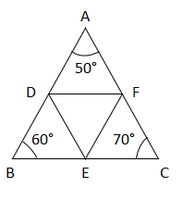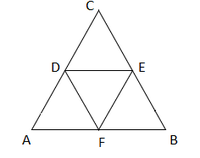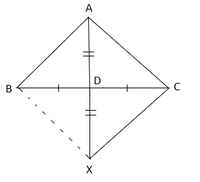问题1.在ΔABC中,D,E和F分别是BC,CA和AB的中点。如果侧面AB,BC和CA的长度分别为7cm,8 cm和9 cm,请找到ΔDEF的周长。
解决方案:

From the question it is given that
AB = 7 cm, BC = 8 cm, AC = 9 cm
Find: the perimeter of ΔDEF
In ∆ABC,
D, E and F are the mid points of BC, CA and AB.
So, by midpoint theorem
EF = 1/2 BC,
DF = 1/2 AC and DE = 1/2 AB
Now, we find the perimeter of ΔDEF
So, Perimeter of ∆DEF = DE + EF + DF
= (1/2) AB + (1/2) BC + (1/2) AC
= 1/2 (AB + BC + AC)
= 1/2(7 + 8 + 9)
= 1/2 (24)
= 12 cm
Hence, the perimeter of ΔDEF is 12 cm
问题2:在ΔABC中,∠A= 50°,∠B= 60°,∠C= 70°。找到通过连接三角形三角形各边的中点而形成的三角形角度的度量。
解决方案:

From the question it is given that
∠A = 50°, ∠B = 60° and ∠C = 70°
In ΔABC,
D, E, and F are mid points of AB, BC, and AC
So from Midpoint Theorem
DE ∥ AC, DE = (1/2) AC
DE = (1/2) AC = CF
In Quadrilateral DECF
DE ∥ AC, DE = CF [Proved above]
Hence, DECF is a parallelogram.
So, ∠C = ∠D = 70° [Because the opposite sides of a parallelogram are equal]
Similarly,
BEFD is a parallelogram,
So, ∠B = ∠F = 60°
ADEF is a parallelogram,
So, ∠A = ∠E = 50°
Hence, the angles of ΔDEF are
∠D = 70°, ∠E = 50°, ∠F = 60°
问题3.在三角形中,P,Q和R分别是边BC,CA和AB的中点。如果AC = 21厘米,BC = 29厘米,AB = 30厘米,请找到四边形ARPQ的周长。
解决方案:

From the question it is given that
AC = 21cm, BC = 29 cm and AB = 30 cm
In ΔABC,
R and P are mid points of AB and BC
So from Midpoint Theorem
RP ∥ AC, RP = (1/2) AC
In quadrilateral ARPQ,
RP ∥ AQ, RP = AQ [Because the opposite sides of a parallelogram
are equal and parallel to each other]
Hence, AQPR is a parallelogram
Now,
AR = (1/2) AB = 1/2 x 30 = 15 cm
So, AR = QP = 15 cm [Because the opposite sides of a parallelogram are equal]
Similarly,
RP = (1/2) AC =1/2 x 21 = 10.5 cm
So, RP = AQ = 10.5 cm [Because the opposite sides of a parallelogram are equal]
Now we find the perimeter of the quadrilateral ARPQ
So, Perimeter of ARPQ = AR + QP + RP + AQ
= 15 + 15 + 10.5 + 10.5
= 51 cm
Hence, the perimeter of the ARPQ = 51cm
问题4:在ΔABC中,将中位数AD生成为x,使得AD = DX。证明ABXC是平行四边形。
解决方案:

From the question it is given that
AD = DX
BD = DC
To prove: Prove that ABXC is a parallelogram.
Proof: Now,
In a quadrilateral ABXC, we have
AD = DX [Given]
BD = DC [Given]
So, diagonals AX and BC bisect each other.
Hence, ABXC is a parallelogram
问题5.在ΔABC中,E和F分别是AC和AB的中点。 AP到BC的海拔高度在Q处与FE相交。证明AQ = QP。
解决方案:

In ΔABC
E and F are mid points of AB and AC
So from midpoint theorem
EF ∥ FE, (1/2) BC = FE
Similarly,
In ΔABP
F is the mid-point of AB
So, from mid-point theorem
So, FQ ∥ BP [since EF ∥ BP]
Q is the mid-point of AP
Hence AQ = QP
问题6.在ΔABC中,BM和CN分别垂直于B和C在通过A的任何直线上。如果L是BC的中点,则证明ML = NL。
解决方案:

In ΔBLM and ΔCLN
∠BML = ∠CNL = 90°
BL = CL [Because L is the mid-point of BC]
∠MLB = ∠NLC [Because vertically opposite angle]
So, ΔBLM ≅ ΔCLN
Hence, by corresponding parts of congruent triangles
LM = LN
问题7。在图中,三角形ABC是在B处的直角三角形。假设AB = 9 cm,AC = 15 cm,而D,E分别是AB和AC边的中点,则计算
(i)公元前的长度
(ii)ΔADE的面积。

解决方案:
From the question it is given that
AB = 9 cm, AC = 15 cm, ∠B = 90°
D, E are the mid-points of AB and AC
In ΔABC,
Using Pythagoras theorem
AC2 = AB2 + BC2
= 152 = 92 + BC2
= BC2 = 225 – 81 = 144
BC = 12
Similarly,
AD = DB = AB/2 = 9/2 = 4.5 cm [D is the mid−point of AB]
D and E are mid-points of AB and AC
So, from mid-point theorem
DE ∥ BC ⇒ DE = BC/2
Now, we find the area of ΔADE
So, Area = 1/2 x AD x DE
= 1/2 x 4.5 x 6
= 13.5
Hence, the area of ΔADE is 13.5 cm2
问题8.在图中,M,N和P分别是AB,AC和BC的中点。如果MN = 3厘米,NP = 3.5厘米,MP = 2.5厘米,则计算BC,AB和AC。

解决方案:
From the question it is given that
MN = 3 cm, NP = 3.5 cm and MP = 2.5 cm.
Find: the value of BC, AB and AC
In ΔABC
M and N are mid-points of AB and AC
So, from mid-point theorem
MN = (1/2) BC, MN ∥ BC
= 3 = (1/2) BC
= 3 x 2 = BC
= BC = 6 cm
Similarly,
AC = 2MP = 2 (2.5) = 5 cm
AB = 2 NP = 2 (3.5) = 7 cm
Hence, values of BC, AB, and AC are 6 cm,7 cm, and 5 cm
问题9. ABC是一个三角形,并且通过A,B,C线分别平行于BC,CA和AB绘制,分别与P,Q和R相交。证明ΔPQR的周长是ΔABC的周长的两倍。
解决方案:

To prove: Perimeter of ΔPQR is double the perimeter of ΔABC.
Proof:
In ΔABC
It is given that the ΔABC pass through A, B, C lines are drawn
parallel to BC, CA and AB and intersecting at P, Q and R.
So, ABCQ and ARBC are parallelograms.
BC = AQ and BC = AR [ Because the opposite sides of a parallelogram are equal]
= AQ = AR
= A is the mid-point of QR
Now we know that,
B and C are the mid points of PR and PQ
So, from mid-point theorem
AB = (1/2) PQ, BC = (1/2) QR, CA = (1/2) PR
= PQ = 2AB, QR = 2BC and PR = 2CA
= PQ + QR + RP = 2 (AB + BC + CA)
Perimeter of ΔPQR = 2 (perimeter of ΔABC)
Hence proved.
问题10.在图中,BE⊥AC,AD是从A到BC与BE在H中相交的任意线。P,Q和R分别是AH,AB和BC的中点。证明∠PQR= 90°

解决方案:
From the question it is given that
BE ⊥ AC and P, Q and R are the mid-point of AH, AB and BC.
To prove: ∠PQR = 90°
Proof:
In ΔABC,
Q and R are mid-points of AB and BC
So, from mid-point theorem
QR ∥ AC ….. (i)
In ΔABH,
Q and P are the mid-points of AB and AH
So, from mid-point theorem
QP ∥ BH ….. (ii)
But, BE⊥AC
So, from eq(i) and (ii) we have,
QP⊥QR
∠PQR = 90°
Hence Proved